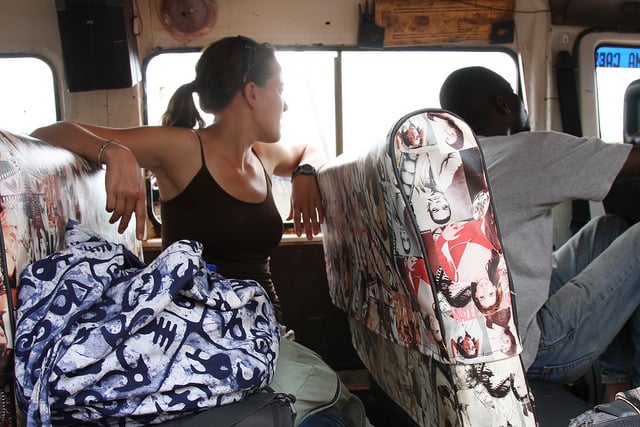
Arriving into Africa from my home region of New York, I was immediately overwhelmed by the sites and sounds of Africa. Experiencing standstill traffic and air saturated with diesel fuel while hawkers (men carrying goods and women selling merchandise from their heads) bang on the taxi window and try to get you to buy an apple, a plunger, an Etcha-Sketch, or a sponge. Locals shout “oburoni!” (foreigner) at you as they try to get your attention and maybe even chat with you. Luckily, you are safe in your taxi.
However, if you are going to be staying in Ghana for more than a day or two, it is likely you are going to end up having to take a trotro, especially if you don’t want to keep paying the “oburoni” price for cabs, which can sometimes even be five times higher than what a local pays.
Trotros can be intimidating, and when I first laid eyes on one amidst the shouting Ghanians and Indie 500-style drivers, I vowed I would walk to another city before boarding one. But when blistered toes and a dwindling wallet got the best of me, I decided to learn how to take this daunting method of public transportation.
1. It’s Usually Easier To Travel In Small Groups
Even though they pack trotros to capacity (don’t be surprised if you have a very squishy ride with someone who may or may not be wearing deodorant), if you are with a large group you may find yourself waiting hours for a trotro that can fit you and your friends. That being said, if you are leaving the city and taking one of the trotros where you must buy your ticket before boarding you’ll have an easier time fitting. If not, you can wait for the next trotro to arrive. Just be aware there aren’t set times for these vehicles.
2. Bring A Book
If you are going a far distance on the trotro, for example, traveling from Accra to Cape Coast, you will purchase your ticket before boarding. In these cases, the trotros do not leave until they are full. This could take 10 minutes, or this could take 3 hours (as I have experienced when going from Accra to Hohoe in the Volta Region). Bring activities to keep yourself occupied.
3. For Shorter Distances Pay Onboard
If you are traveling within the same city you can pay while on board the trotro, usually 30-60 pesewas (about $0.08 to $0.25 USD). The money-collector will collect your money while the trotro is in motion, and you can signal with your fingers how many people you are paying for. If you do not know the fare, try watching other people pay and see what kind of change they get back. And, because the fare is usually less than 1 New Ghana Cedi (about $0.41 USD), you can give 1 New Ghana Cedi and that will usually be enough.
4. Keep Your Personal Belongings Close To You
While most of the people I have met on the trotro have been nice, it never hurts to be careful. More than once I have had hawkers ambush a trotro, asking for money and even trying to grab my iPod. Be aware of who is around you and where your things are.
5. Don’t Be Afraid To Ask For Directions
If you are not sure how to get to a certain destination ask the trotro driver. It can be intimidating at first, but they are more than happy to help you. Many of the drivers I asked for directions even walked me to where I needed to go. It can also be helpful to carry a paper and pen in case there is a communication barrier, so you can write down the name of the destination you are looking to go.
6. Use The Bathroom Beforehand
After reading the above tips, it probably won’t surprise you to learn there are no bathrooms on board the trotro. For this reason, it’s imperative to use the toilet before boarding, especially if your journey is a few hours long. In an emergency, you can ask the driver to pull over on the side of the road so you can use Mother Nature as a restroom, but use this as a last resort.
7. Get A Window Seat
The window seat is best not only for the view and for control of the fresh air that comes in, but also because of the hawkers. At every light, hawkers will rush to the window to sell toys, housewares, cosmetics, and, the best part, food and drink. It’s a great way to grab a cheap snack on the go in a local fashion.
Have you ever ridden the tro-tro in Ghana? What tips would you add? What was your experience like?
Learning to ride the tro-tro is necessary when visiting Ghana. Photo courtesy of Rachel Zack.

Jessica Festa is the editor of the travel sites Jessie on a Journey (http://jessieonajourney.com) and Epicure & Culture (http://epicureandculture.com). Along with blogging at We Blog The World, her byline has appeared in publications like Huffington Post, Gadling, Fodor’s, Travel + Escape, Matador, Viator, The Culture-Ist and many others. After getting her BA/MA in Communication from the State University of New York at Albany, she realized she wasn’t really to stop backpacking and made travel her full time job. Some of her most memorable experiences include studying abroad in Sydney, teaching English in Thailand, doing orphanage work in Ghana, hiking her way through South America and traveling solo through Europe. She has a passion for backpacking, adventure, hiking, wine and getting off the beaten path.








